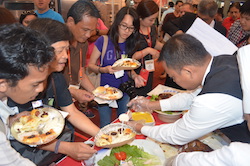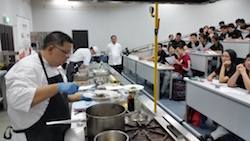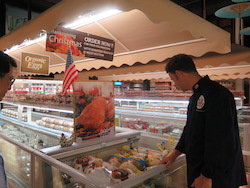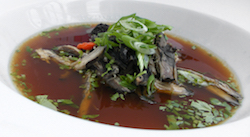| |
 |
February 2016 |
 |
|
| |
| |
|
Welcome
Welcome to the February issue of the USAPEEC ASEAN Regional Office’s newsletter.
This newsletter seeks to provide readers with useful product and major market information for institutional and consumer users of U.S. poultry. Readers will find in every issue a variety of general market information, program activities as well as useful product information.
This month, we take a look at several market perspectives in the individual ASEAN countries.
Contents:
- Philippines is the largest market in ASEAN for imported U.S. high value foods
- Poultry curriculum students treated to a demonstration of master class skills
- Thailand offers market opportunities for high value foods and ingredients
- Chicken Soup for the Soul
- Pairing cocktails with meat dishes
|
|
|
| |
|
|
|
| |
|
Additional Market Information Available
We have updated our website to include more information on market reports and export documentation guidelines.
You can visit our ASEAN website at: www.usapeecasean.com |
|
|
| |
|
|
|
 |
|
Philippines is the largest market in ASEAN for imported U.S. high value foods
Among all the nations within the ASEAN grouping, the Philippines is the largest market for imported U.S. foods. Imports of U.S. foods totalled US$1.1 billion in 2014 (latest full year records).With a population of 104 million and rapidly rising consumer incomes, the Philippines is the 10th largest export market for U.S. consumer oriented foods. The country imported US$594 million of high value consumer food products for the first eight months of 2015. The growing appetite for consumer oriented foods from the U.S. may be attributed to the following factors:
- Filipinos have a strong preference for U.S. food and beverage products.
- U.S. brands are perceived to be safe and of high quality.
- Growing middle income group results in greater affordability of imported U.S. food products
- Rise in the demand for convenience meals and heat and serve meals.
Some of the U.S. foods that are considered to have the best market prospects include: dairy products, poultry, beef, pork, tree nuts, processed vegetables, snack foods, prepared foods fresh fruit, chocolate and cocoa products and egg and egg products.
For more detailed reports on the Philippines retail food industry and the Philippines food service sector, please click into the following links: (1) (2) |
|
Philippine trade visitors crowd US Poultry Booth at WOFEX Show in Manila |
| |
|
|
|
|
|
Poultry curriculum students treated to a demonstration of master class skills
Recently graduated culinary students of SHATEC who had completed the poultry curriculum courses attended the two master classes conducted by celebrity and well known Singapore chefs. The classes offer the participants the unique opportunity to witness the master chefs applying the specially created delicious recipes for local poultry favourite dishes prepared in the most amazing eye opening methods.
The classes took place in SHATEC’s culinary school over two afternoons on Jan 28 2015 and on February 3 2016. In the first Master class on Jan 28, Celebrity Chef Eric Low presented the use of U.S. braised duck in local sauce, as well as sous vide chicken roulade in fermented sauces both of which are favourite Singapore dishes while in the following week, Celebrity Chef Elvin Chew taught the novel ways of preparing U.S. turkey in a couple of outdoor casual dining dishes, turkey sliders and turkey meatballs. |
|
 |
Local celebrity chef Eric Low conducts Master Class for poultry curriculum students |
| |
| |
|
|
|
 |
|
Thailand offers market opportunities for high value foods and ingredients
Thailand, as ASEAN’s second largest economy offers significant market opportunities for U.S. exporters of consumer oriented foods as well as food ingredients.
Currently, Thailand is the 18th largest export market for U.S. agricultural products. Imports of consumer oriented foods from the United States totalled US$414 million in 2014(latest full calendar year results).
The favourable factors that the Thai market offer include a large middle income segment of 34 million consumers, a relatively youthful population (31 % of the population is between the ages of 15-35 years) and a higher percentage of consumers living in urbanized areas who are very receptive to imported western type products. Other factors favouring imported western type consumer oriented foods include the rapidly growing tourist arrivals (29.5 million visitors in 2015) as well as the increasing number of western fast food and casual dining restaurants.
The best market prospects for U.S. suppliers to the retail food sector include fresh fruit, tree nuts frozen fries, scallops, snack foods, breakfast cereals, wine, dried fruit, popcorn and pet foods.
The hotel restaurant industry offers exciting market prospects for U.S. suppliers of U.S. beef, turkey, seafood, Alaskan king crab, scallop, mussels and oysters, dairy products, fresh fruit and vegetables, frozen berries, frozen peas, fruit juice, dried fruit, wine and whisky.
For more information on the Thailand Exporter Guide, please click into the attached link: (1) |
|
U.S. turkey promotion in a Thai supermarket |
| |
| |
|
|
|
 |
|
Chicken Soup for the Soul
There are various chicken soups available all around the world and they have become a time-honoured remedy for cough, cold and many other ailments. In this article, we will be exploring some of these chicken soup recipes to heal the body and soul.
Black chicken (Silkie) soup is known for its energy replenishing properties in traditional Chinese medicine. Silkie chicken is most commonly known to originate from China. The breed has several unusual qualities, such as black skin and bones, blue earlobes, and five toes on each foot, whereas most chickens only have four. They are often exhibited in poultry shows and appear in various colours. Outside of Asia, black chicken is rather uncommon.
Silkie meat is an ingredient in Asian cuisine, especially that of Chinese, Japanese and Korean dishes. The chicken flesh itself is a dark bluish-grey or even black, and the bones are black as well. While some claim that there is no difference in flavour, others say that the meat is more tender. Recent studies have found that silkie chickens have double the amount of antioxidant carnosine. Silkie meat is also lower in fat. A 100gram piece of regular chicken has around 8 grams fat, while silkie meat has only 2 grams.
Silkie meat is used to prepare black chicken soup in Singapore. Black chicken soup is often cooked with red dates, goji berries and Codonopsis Pilosula Root (Dang Shen) to relieve fatigue. It is also said to help the lungs, blood and stomach.
There are also many chicken soups used around the world. In South Korea, one of the many must-try food includes their ginseng chicken soup (Samgyetang). Samgyetang is known as a cure for common ailments and as a summertime rejuvenation dish.
Given the traditional herbal additives used when cooking the dish, the soup is generally considered a summertime meal served hot and meant to replace the lost energy and vitamins taken by the heat. Samgyetang is typically made with a young chicken stuffed with rice, peeled chestnuts, and jujubes. It is then boiled in a ginseng broth.
Growing up in an Asian country, many would have heard that consumption of chicken when having a cough is a big no-no. However, consumption of protein foods can actually help strengthen the respiratory system. Chicken is not recommended for heaty coughs, where symptoms include a chesty cough and yellow phlegm.
In many western countries, chicken soup is a home remedy for colds and flu. A couple of studies show that chicken soup actually does help to reduce upper respiratory cold symptoms. |
|
Black Chicken (Silkie) Soup
Credit: Robin |
| |
|
|
|
 |
|
Pairing cocktails with meat dishes
Although wine is traditionally used to complement fine dining, in recent years cocktails have risen in popularity on the beverage menu. By carefully selecting ingredients in the drink, cocktails can also be used to bring out the flavours of the main course. In this article we explore the various strategies of pairing food with cocktails.
There are a few considerations before pairing food with cocktails.
Firstly, one should consider the consistency of a cocktail. Frozen cocktails are thicker in consistency and can be overwhelming on the palate. Fizzy, carbonated cocktails go well with full-bodied, rich-tasting food such as pork and beef.
When looking for an ideal marriage of a cocktail and dishes, consider a variation of having similar and contrasting flavours. Bourbon would go very well with a barbecued steak since the smoky flavour of the spirit complements the smoky meat. Alternatively, you can contrast the taste of pairing a spicy chicken curry with a cooling flavour such as a Mojito.
Adding herbs and fruits to match the food is a good, fuss-free way to unite cocktails with food. Strong citrus flavour in a lemon drop, or even lime, goes well with fresh seafood such as raw oysters. Sage marries well with tequila, so does gin with rosemary, or rum with mint.
Since herbal or fruit cocktails make such complimentary pairings to food, mixologists in Bangkok have come up with sous vide methods to produce a more strongly-flavoured herbal/fruit cocktail. Sous vide is a method in which food is sealed in airtight plastic bags then placed in a water bath or in a temperature-controlled environment. This is commonly used to cook meat, especially chicken.
The process of vacuum-sealing a base spirit with ingredients such as fruits, herbs or sugars, and then heating it in a sous vide water bath works incredibly well and works quickly in binding flavours and aromas to spirits.
While cold infusion is not a problem for heavier ingredients like vanilla and star anise, it is too slow and mild a method for lighter herbs and fruits flavours. Examples include rhubarbs, raspberries, cacao nibs, green apple or black pepper. On the other hand, traditional cooking methods are too harsh and destroy the flavour. This is where sous vide helps to preserve the flavour of these lighter herbs and fruits. |
|
Cocktails
Credit: Kirti Poddar |
|
Disclaimer: All opinions and views expressed in the articles published in the newsletter are those of the individual journalists and do not necessarily reflect those of the publisher, the newsletter's sponsors or USA Poultry & Egg Export Council.
You have received this email because you have registered to get newsletters from USAPEEC ASEAN.
If you prefer not to receive these updates, please
click here
to unsubscribe.
Do not reply to this email. For enquiries, go to www.usapeecasean.com
® USA POULTRY & EGG EXPORT COUNCIL
541 Orchard Road, #15-04, Liat Towers, Singapore 238881 Tel: (65) 67371726 Fax: (65) 67371727
*|REWARDS|* |
|
|
|